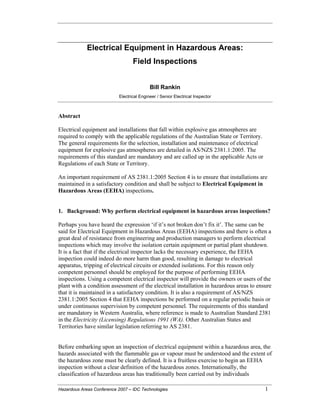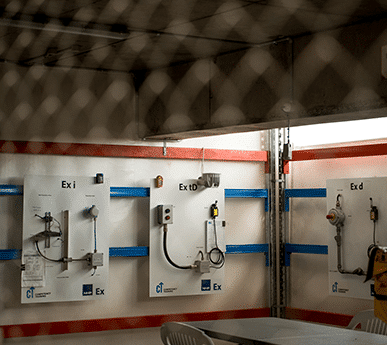The Basic Principles Of Roar Solutions
The Basic Principles Of Roar Solutions
Blog Article
The Basic Principles Of Roar Solutions
Table of ContentsThe Best Guide To Roar SolutionsSome Known Facts About Roar Solutions.An Unbiased View of Roar Solutions
In order to safeguard setups from a possible surge a technique of analysing and categorizing a potentially unsafe area is required. The objective of this is to ensure the right choice and installation of devices to inevitably avoid an explosion and to make certain safety and security of life.
(https://forums.hostsearch.com/member.php?272308-roarsolutions)
No tools must be set up where the surface area temperature level of the devices is above the ignition temperature of the given threat. Below are some typical dust unsafe and their minimal ignition temperature level. Coal Dirt 380C 225C Polythene 420C (thaws) Methyl Cellulose 420C 320C Starch 460C 435C Flour 490C 340C Sugar 490C 460C Grain Dirt 510C 300C Phenolic Material 530C > 450C Aluminium 590C > 450C PVC 700C > 450C Soot 810C 570C The probability of the danger being present in a concentration high adequate to cause an ignition will differ from place to place.
In order to categorize this danger an installment is separated into areas of threat relying on the quantity of time the dangerous is present. These areas are described as Areas. For gases and vapours and dusts and fibers there are three zones. Area 0 Area 20 A dangerous environment is highly most likely to be present and might exist for extended periods of time (> 1000 hours each year) and even continually Zone 1 Zone 21 An unsafe ambience is possible but not likely to be present for long durations of time (> 10 450 C [842 F] A category of T6 indicates the minimum ignition temperature level is > 85 C [185 F] Hazardous location electrical equipment possibly developed for use in greater ambient temperatures. This would suggested on the ranking plate e.g. EExe II C T3 Ta + 60C( This implies at 60C ambient T3 will not be exceeded) T1 T1, T2, T3, T4, T5, T6 T2 T2, T3, T4, T5, T6 T3 T3, T4, T5, T6 T4 T4, T5, T6 T5 T5, T6 T6 T6 A T Class ranking of T1 implies the maximum surface temperature level produced by the tool at 40 C is 450 C. Assuming the connected T Course and Temperature ranking for the equipment are appropriate for the area, you can always utilize a tool with an extra rigorous Department ranking than required for the area. There isn't a clear solution to this question. It really does depend on the kind of devices and what repair services require to be executed. Tools with details test treatments that can not be performed in the field in order to achieve/maintain 3rd event score. Must come back to the manufacturing facility if it is before the devices's service. Field Repair Service By Authorised Employee: Challenging screening might not be needed nevertheless certain treatments may need to be followed in order for the equipment to preserve its 3rd party ranking. Authorized employees should be used to do the job correctly Repair service must be a like for like substitute. New component must be taken into consideration as a straight replacement calling for no special screening of the equipment after the repair is total. Each piece of tools with a dangerous ranking must be evaluated independently. These are described at a high degree listed below, however, for even more detailed information, please refer directly to the guidelines.
How Roar Solutions can Save You Time, Stress, and Money.
The tools register is an extensive data source of devices documents that consists of a minimum collection of areas to identify each product's place, technical criteria, Ex classification, age, and environmental information. This information is vital for monitoring and managing the devices successfully within hazardous areas. In contrast, for routine or RBI sampling assessments, the grade will be a mix of Comprehensive and Close evaluations. The proportion of In-depth to Shut inspections will certainly be identified by the Equipment Threat, which is assessed based upon ignition danger (the likelihood of a source of ignition versus the likelihood of a flammable ambience )and the dangerous area category
( Area 0, 1, or 2). This variation will also affect the resourcing requirements for work prep work. As soon as Lots are defined, you can establish tasting strategies based on the sample dimension of each Whole lot, which describes the variety of arbitrary equipment items to be examined. To figure out the needed sample dimension, 2 elements need to be examined: the size of the Whole lot and the group of assessment, which indicates the level of initiative that should be used( reduced, normal, or raised )to the inspection of the Lot. By integrating the category of assessment with the Lot size, you can after that develop the proper rejection criteria for an example, indicating the allowable variety of defective items discovered within that sample. For even more information on this procedure, please refer to the Power Institute Standards. The IEC 60079 typical recommends that the maximum interval between assessments ought to not go beyond 3 years. EEHA examinations will certainly also be conducted beyond RBI campaigns as component of set up maintenance and devices overhauls or repair services. These evaluations can be attributed toward the RBI sample sizes within the affected Lots. EEHA evaluations are performed to recognize mistakes in electric equipment. A heavy racking up system is essential, as a single item of equipment may have several faults, each with varying degrees of ignition risk. If the consolidated score of both examinations is much less than twice the fault score, the Lot is considered acceptable. If the Great deal is still thought about undesirable, it has to undergo a complete assessment or reason, which might trigger stricter evaluation methods. Accepted Whole lot: The root causes of any faults are determined. If a common failing setting is discovered, additional tools might need maintenance. Mistakes are categorized by severity( Safety and official source security, Honesty, House cleaning ), guaranteeing that urgent concerns are assessed and resolved immediately to reduce any kind of effect on safety or operations. The EEHA data source must track and record the lifecycle of mistakes along with the restorative actions taken. Carrying out a robust Risk-Based Assessment( RBI )method is important for ensuring conformity and security in taking care of Electrical Devices in Hazardous Areas( EEHA) (Roar Training Solutions). Automated Mistake Rating and Lifecycle Monitoring: Easily take care of mistakes and track their lifecycle to improve examination accuracy. The introduction of this support for risk-based evaluation further strengthens Inspectivity's placement as a best-in-class option for regulative compliance, as well as for any kind of asset-centric assessment use instance. If you have an interest in discovering more, we invite you to request a demo and discover just how our option can change your EEHA monitoring processes.
5 Easy Facts About Roar Solutions Explained

In terms of explosive threat, a hazardous area is a setting in which an explosive atmosphere is existing (or may be anticipated to be existing) in amounts that need special precautions for the construction, setup and use tools. Roar Solutions. In this short article we discover the challenges dealt with in the office, the risk control steps, and the required competencies to function securely
These substances can, in specific problems, create eruptive ambiences and these can have major and terrible repercussions. Most of us are acquainted with the fire triangle get rid of any type of one of the three elements and the fire can not occur, but what does this mean in the context of dangerous locations?
In the majority of instances, we can do little regarding the degrees of oxygen airborne, but we can have significant influence on sources of ignition, for instance electric equipment. Unsafe areas are documented on the hazardous area category drawing and are recognized on-site by the triangular "EX-SPOUSE" indicator. Below, among other key details, areas are divided right into 3 types depending on the hazard, the possibility and period that an explosive atmosphere will exist; Zone 0 or 20 is deemed the most unsafe and Zone 2 or 22 is deemed the least.
Report this page